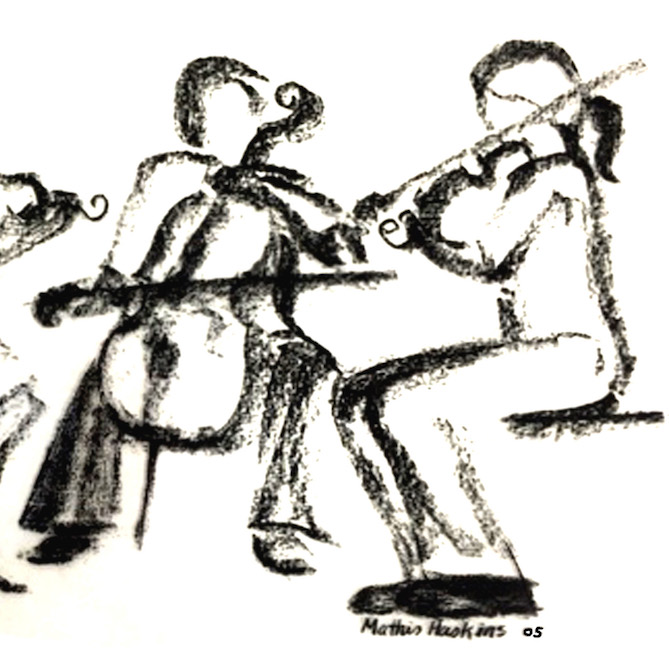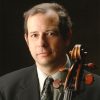
Developing Musicianship Through Chamber Music
Thomas Rosenberg
In a typical private instrumental lesson, until a student has reached a fairly high technical level, much of the time in a lesson is spent on issues such as good hand positions, intonation, tone production, fingerings and bowings, and the development of technique in both hands through scales, etudes, etc. The choice of a solo piece or pieces is usually connected to these same issues. Musicianship is hopefully discussed, and hopefully in some detail. But, the fact remains that it is unlikely issues of musicianship will dominate the lesson time.
One of the great benefits of having students play chamber music is that it helps them become better musicians faster. A good, well matched chamber music group with a good coach will push forward the abilities a student has already developed and enable them to be able to play everything on the page. This includes the more empirical things that are in ink such as the notes, the rhythm and the basic dynamics. Then there more subjective elements such as crescendos and diminuendos, accellerandos and ritardandos, tempo changes, tone color instructions (i.e. sul tasto, espressivo, sul ponticello), mood suggestions from the composer (i.e. tranquillo, con forza) and articulation suggestions through the use of symbols and words. Beyond that are the things not specifically instructed by the composer. These more intellectual and intuitive issues include how a phrase should be shaped, the pacing of an entire movement, how to convey the emotions in the music to the audience, how to lead and cue, and how to really listen.
A vast majority of students will do some ensemble work. They usually will play with others in a school orchestra, or a local regional youth symphony. These types of groups are great for many reasons. It can really help a student to be in a group with many others to help them realize that there is more to their instrumental training than the practice room and private lesson time. It also is hopefully fun and there is a lot of great music. In a good youth orchestra setting, many of the issues mentioned in the previous paragraph are touched on, and that is good. However, by the nature of an orchestra, these things can only be touched on. In string sections, it is rare for a student to be playing alone, and even more rare to be playing with only one member of each of the other string sections. In rehearsals, the conductor, or leader of a string sectional can usually only work on getting a group of players to generally do the same thing. I have observed many very good players who have played youth orchestra for numerous years come into a chamber music setting and still not really know how to do these things. Their listening skills and leading abilities are also only partially developed. This may be because in an orchestra it is easy to feel one is not personally responsible for the musical decisions, and one is supposed to blend into the group. In addition, it is just not practical for the conductor to listen to each individual player and spend significant time with them working on these skills.
A well-balanced and well-coached chamber music group is different. The students are personally required to take full musical responsibility. The students are personally required to play really in tune. The students are personally required to use the bow creatively and artistically. They are personally required to make the dynamics, tempo changes, issues of timbre, balance, etc. They are personally responsible for the shape of the phrasing. Unlike in a student orchestra where there are others to help and a conductor to make decisions, if they don’t do these things, they won’t happen! And, they each are constantly being carefully listened to by a coach and each other. There is also the possibility that members of a chamber ensemble will develop real friendships. Groups that stay together for a number of years often become best of friends, develop a group personality of their own, take on a name, and as they get older and more responsible, even put on their own concerts! Unfortunately, it is still a small minority of students who have a significant chamber music experience.
Here is just one example of how when working with a group, I will challenge the students to really think about the phrasing. I try to explain that just as in speaking, even though you may be using one general speaking level, there is still shape, changes in color and emphasis on a specific part of the sentence. A composer may only write one dynamic for a phrase, yet that doesn’t mean the notes should all be played the same. An interesting experiment is this: give each member of the group the same passage from a good book and ask them to read it as if they were an actor on a stage. Each of them will do it differently! Some will be very effective, while others might be less, or even expressionless. The point is that the author wrote the words, but leaves the delivery of the words up to the imagination of the reader, usually with little instruction other than simple tools such as italics or punctuation marks. Although it may be necessary to give the students some help in making the passage sound good, most have the natural ability to quickly assimilate ideas and have their voices recreate the ideas. Next, have them read it together and try to shape it the same way. They will see that there are often are many ways to make a phrase sound great…but rarely does it involve lack of shape or expression. Next, just as they did with reading from the book, now have them sing a passage from their music individually and then together. Often they will sing a phrase more naturally than they can play it on their instrument. (When you think about it, that is probably why teachers and conductors, many of whom have no real vocal training, will sing their phrasing or articulation ideas to their students or fellow musicians.) Finally, have the students try the same thing with their instrument and see how closely they can match. The coach can really help facilitate this process. More advanced groups can try several different ideas for shaping the same phrase.
Of course, there are also many other ways to help students bring a score to life. Usually, once they understand that they have been given this great responsibility, most really strive to greatly expand their musical skills and start paying much closer attention to the details that make a performance great.
I believe that studio teachers can really help their students develop more quickly by urging them to consider chamber music as an important part of their training, at least equally important as orchestra. And, just as it is true with the conductor of a student orchestra, the guidance of a skilled coach can make a big difference in the training students receive.
Subjects: Chamber Music
